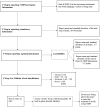A systematic review on nomophobia prevalence: Surfacing results and standard guidelines for future research
- PMID: 34003860
- PMCID: PMC8130950
- DOI: 10.1371/journal.pone.0250509
A systematic review on nomophobia prevalence: Surfacing results and standard guidelines for future research
Abstract
Background: Mobile phones allow us to stay connected with others and provide us a sense of security. We can work, chat with family and friends, take pictures, buy clothes or books, and even control home appliances. They play such a significant role in our lives that we feel anxious without them. In some cases, the relationship between humans and these communication devices have become problematic. Nomophobia (NMP) is the fear of becoming incommunicable, separated from the mobile phone and losing connection to the Internet. Since this social phobia was coined in the first decade of the XXI century, a growing number of studies have studied it and reported the prevalence of this technology-related problem. However, this research activity has generated mixed results regarding how we assess and report nomophobia and who may be at a higher risk of suffering or developing it.
Methods: We conducted a systematic review of 108 studies published in English and Spanish and collected them in Parsifal. We searched for assessment and prevalence data on nomophobia. Also, we looked at gender and age differences to identify risk factors and see if these differences exist and emerge worldwide.
Results: In this study, we find that women and younger individuals suffer more from nomophobia. The disparity in reporting the prevalence of nomophobia is enormous since the percentages of "at-risk" participants go from 13% to 79%, and participants suffering from it are between 6% and 73%, being the score in the range of 45.5 and 93.82. Within the group of nomophobic people, moderate cases vary between 25.7% and 73.3%, and severe cases, between 1% and 87%. Such disparity is due to differences in assessment criteria. Females and young people seem to be more vulnerable to nomophobia although methodological disparity makes it difficult to reach definitive conclusions. We conclude our review by recommending some common guidelines for guiding future research.
Conflict of interest statement
The authors have declared that no competing interests exist.
Figures






Similar articles
-
Nomophobia: Is the Fear of Being without a Smartphone Associated with Problematic Use?Int J Environ Res Public Health. 2020 Aug 19;17(17):6024. doi: 10.3390/ijerph17176024. Int J Environ Res Public Health. 2020. PMID: 32824979 Free PMC article.
-
Nomophobia in Lebanon: Scale validation and association with psychological aspects.PLoS One. 2021 Apr 20;16(4):e0249890. doi: 10.1371/journal.pone.0249890. eCollection 2021. PLoS One. 2021. PMID: 33878132 Free PMC article.
-
Adaptation of the Nomophobia Questionnaire (NMP-Q) to Spanish in a sample of adolescents.Actas Esp Psiquiatr. 2017 Jul;45(4):137-44. Epub 2017 Jul 1. Actas Esp Psiquiatr. 2017. PMID: 28745386
-
The Emerging Phenomenon of Nomophobia in Young Adults: A Systematic Review Study.Addict Health. 2021 Apr;13(2):120-136. doi: 10.22122/ahj.v13i2.309. Addict Health. 2021. PMID: 34703533 Free PMC article. Review.
-
Nomophobia: An Individual's Growing Fear of Being without a Smartphone-A Systematic Literature Review.Int J Environ Res Public Health. 2020 Jan 16;17(2):580. doi: 10.3390/ijerph17020580. Int J Environ Res Public Health. 2020. PMID: 31963208 Free PMC article.
Cited by
-
Adverse Effects of Smartphone Addiction among University Students in South Korea: A Systematic Review.Healthcare (Basel). 2022 Dec 21;11(1):14. doi: 10.3390/healthcare11010014. Healthcare (Basel). 2022. PMID: 36611474 Free PMC article. Review.
-
Adaptation of the European Portuguese Version of the Nomophobia Questionnaire for Adolescents, Factor Structure and Psychometric Properties.Int J Ment Health Addict. 2022 Jan 10:1-18. doi: 10.1007/s11469-022-00754-9. Online ahead of print. Int J Ment Health Addict. 2022. PMID: 35035315 Free PMC article.
-
Nomophobia is Associated with Insomnia but Not with Age, Sex, BMI, or Mobile Phone Screen Size in Young Adults.Nat Sci Sleep. 2021 Oct 28;13:1931-1941. doi: 10.2147/NSS.S335462. eCollection 2021. Nat Sci Sleep. 2021. PMID: 34737661 Free PMC article.
-
Study protocol of a proposed Neurofeedback-Assisted Mindfulness Training Program on symptoms of anxiety and psychological distress associated with smartphone use in young adults: a randomized controlled trial.Front Public Health. 2024 Sep 4;12:1410932. doi: 10.3389/fpubh.2024.1410932. eCollection 2024. Front Public Health. 2024. PMID: 39296829 Free PMC article.
-
Prevalence and Associated Factors of Nomophobia Amongst the General Population in Makkah Province and Al-Madinah Province, Saudi Arabia: An Analytical Cross-Sectional Study.Clin Pract Epidemiol Ment Health. 2024 May 31;20:e17450179311620. doi: 10.2174/0117450179311620240508105100. eCollection 2024. Clin Pract Epidemiol Ment Health. 2024. PMID: 39130190 Free PMC article.
References
-
- DailyMail. Nomophobia is the Fear of Being Out of Mobile Phone Contact. type. 2008 Available from: https://www.dailymail.co.uk/news/article-550610/Nomophobia-fear-mobile-p....
-
- Worldometer. Current World Population. type. 2020 Available from: https://www.worldometers.info/world-population/.
-
- King ALS, Valença A, Cardoso A, Sancassiani F, Machado S, Nardi A. “Nomophobia”: Impact of Cell Phone Use Interfering with Symptoms and Emotions of Individuals with Panic Disorder Compared with a Control Group. Clinical Practice and Epidemiology in Mental Health. 2014;10:28–35. 10.2174/1745017901410010028 - DOI - PMC - PubMed
-
- Yildirim C. Exploring the Dimensions of Nomophobia: Developing and Validating a Questionnaire Using Mixed Methods research. Iowa State University; 2014.
Publication types
MeSH terms
LinkOut - more resources
Full Text Sources
Other Literature Sources
Medical

